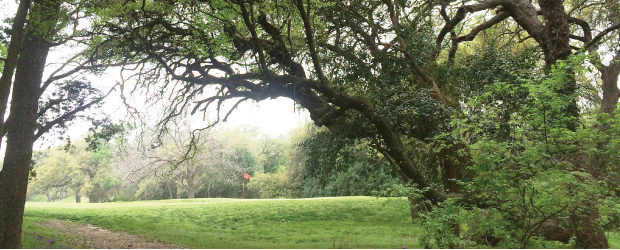The future of Hancock Golf Course remains unknown
Thursday, September 2, 2021 by
Kali Bramble The Parks and Recreation Board revisited the discussion about the fate of the Hancock Golf Course Tuesday while reviewing an extensive survey of public opinion on the matter.
Anthony Segura, a parks department assistant director, and Kevin Gomillion, who manages Golf Operations, presented the results of the two-week survey, which was conducted by the city and gathered over 9,000 responses across all 10 City Council districts.
Using methods ranging from randomized targeting of Austin residents to QR codes posted around the perimeter of the park, the survey posed eight questions about how respondents use the space and how they would like to see it developed.
The presentation largely focused on responses to the survey’s least open-ended question, which asked residents whether they “supported Hancock Golf Course as a public course open to all.” With over two-thirds of respondents saying yes, the presenters argued that the data reflected a community attached to preserving the role of golf at Hancock, but maintained that they were not done gathering all possible perspectives on the issue before moving forward.
Uncertainty over the future of the historic golf course began nearly a decade ago due to financial insolvency, and the issue has grown increasingly acute amidst the intersecting economic pressures of rising costs of living, city budget concerns and pandemic restrictions. Under these conditions, the 45-acre site has become a battleground for a diverse set of opinions and priorities.
One organization that has mobilized around the issue is the Hancock Neighborhood Association, whose president, Coan Dillahunty, spoke on behalf of the group before the survey’s presentation. Reiterating a statement the organization made back in April, Dillahunty expressed the neighborhood’s desire to adhere to a “mixed-usage” model of the park space, with a focus on continuing necessary updates to the aging nine-hole course while also investing in amenities such as trails, soccer fields and playscapes that provide alternatives for non-golfers.
While much of the conversation surrounding Hancock has been dominated by concerns over its past financial troubles, Gomillion presented surprisingly optimistic projections for the future, saying that in 2021 the course has seen “nearly double the rounds of golf” it did in 2018, likely due to the pandemic’s “pushing people toward outdoor activities.”
While an overhaul of the course into a public park has been a popular idea among groups such as Hancock Conservancy, which coalesced around the issue last October, an attachment to the sport of golf dominated both the survey results and the conversation among parks board members.
Neighborhood resident Kevin McKinney gave an impassioned statement summarizing several key themes, noting that the renovation of the park’s irrigation system back in 2014 has had a significant impact on shifting the park’s reputation as a “bad product” toward a “beautiful, affordable, challenging, walkable and historic golf course” that has garnered renewed appreciation throughout the city.
Despite the optimistic tone of the presentation and surrounding conversation, several board members and citizen callers raised important criticisms of the survey’s procedures.
Speaking on behalf of the Austin Justice Coalition, caller Awais Azhar stressed the need for “equitable and transparent community engagement,” raising the point that the survey’s two-week length and overrepresentation of golf players and the surrounding neighborhood excluded working-class communities and historically underrepresented Black and Latino Austinites.
Board member Anna Di Carlo noted that the survey was only made available in English, and requested that future community engagement efforts reconsider this barrier to Austin’s significant population of Spanish speakers.
Segura and Gomillion concluded their presentation saying that the two would continue refining their community engagement efforts with a focus on gathering ideas for the popular shared-use model reflected in the survey’s data.
The program directors proposed reconvening meetings with local organizations in October, when the discussion will be further informed by the conclusion of the fiscal year.
The Austin Monitor’s work is made possible by donations from the community. Though our reporting covers donors from time to time, we are careful to keep business and editorial efforts separate while maintaining transparency. A complete list of donors is available here, and our code of ethics is explained here.
You're a community leader
And we’re honored you look to us for serious, in-depth news. You know a strong community needs local and dedicated watchdog reporting. We’re here for you and that won’t change. Now will you take the powerful next step and support our nonprofit news organization?






